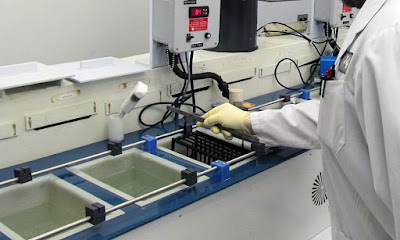Electroplating; Process of Plating/Depositing One Metal onto the Other through Hydrolysis
 |
| Electroplating |
Electroplating is the process of plating a
metal onto the other by hydrolysis to prevent corrosion of metal or for
decorative purposes. Electroplating
is also known as electrodeposition. The process involves depositing material
using an electric current. This process results in a thin layer of metal being
deposited onto the surface of a workpiece called substrate. Electroplating
creates a protective barrier to reduce friction and prevent tarnishing of a
surface as well as protecting the surfaces from wear and tear by applying a
thin, durable metal coating.
Electroplating
is a process that uses
metals to improve the properties of objects. It can improve a variety of
features, including resistance to rust and corrosion, lubricity, reflectivity,
and electrical conductivity. It also improves the adhesion of materials, as
well as improve strength and durability. It is used by artists, engineers, and
manufacturers in a variety of applications. The process involves placing an
anode (metal to be plated) and cathode (object to be plated) in an electrolyte
solution or chemical bath. The anode is then exposed to an external supply of
direct current.
When the circuit is activated, the
dissolved metal ions from the anode are reduced at the cathode to form a
coating of the plated metal. This can occur in a series of steps that take
place inside an electrolytic cell. The cells are made up of a negative
electrode, a positive electrode, and electrolyte solution that contains one or
more metal salts to facilitate flow of electricity. The plating process can be used to coat a
variety of materials, but the most common are nickel, copper, and zinc. These
metals are known for their hardness, tensile strength, and
corrosion-resistance.
There are also specific types of electroplating such as copper plating,
silver plating, and chromium plating. Nickel is the most common electroplated
material. It's used in a multi-layered process, to increase wear and corrosion
resistance. With heat treatment, this wear resistance can be improved even
more. Electroplating is also used to change the physical properties of object,
such as hardness, resistance, brittleness, conductivity, and luster. It can also
be used to give objects increased wear resistance, corrosion protection, and
aesthetic appeal, as well as increased thickness.
Electroplating in India began after independence. In the
early sixties, the plating was done using a dull nickel. Research estimates
that in the 1970s, the size of the electroplating industry was around 100
million, with the first semi-automatic plant established in Mumbai.



Comments
Post a Comment